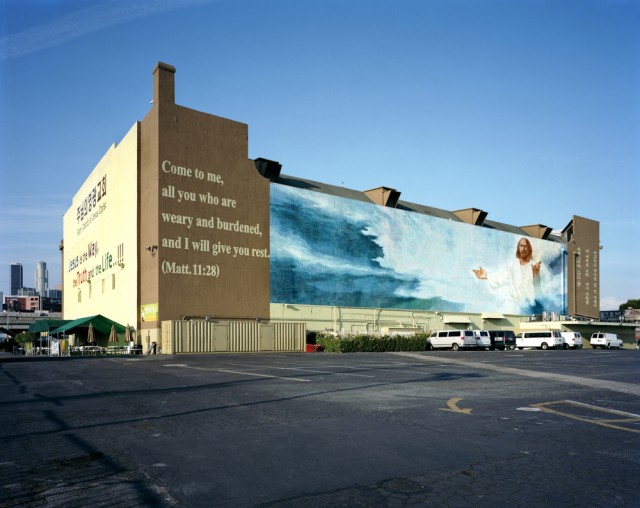Lex orandi, lex credendi, the law of prayer is the law of believing. In other words, the way we pray (and worship) shapes what we believe. But what about where we worship? It is a truism in liturgical planning that “the building always wins.” The design and layout of the worship space speaks loudly to what we believe about God and our mutual relationship. Is God far away and remote? Then lets put an altar far away from the congregation and behind a rood screen (or even an altar rail). Is God immanent only from scripture? Then lets put a pulpit front and center? Anglicanism is a tradition that treasures the beautiful and the sublime, and examples of treasured buildings are numerous.
But it is rare to see a new-built church, especially of the non-denominational mega-church sort, incorporate the kind of traditional church architecture that many Episcopalians are familiar with. Religion Dispatches has a post up highlighting the work of LA-based artist Lisa Auerbach entitled “Megachurches.” Auerbach spent several years touring the United States and taking pictures of churches—exteriors only.
Speaking of the work, and the sense that it documents a kind of anodyne sterility she said;
“It just is what it is. That’s what it looks like. That’s what that strain of faith looks like. Like the look of Catholic cathedrals is very different from megachurches because there really is an idea of the divine in the architecture. Megachurches are more about having a big enough space for everyone to fit in, so it’s really not about this feeling of being small and humbled in the face of a larger power. I get a different feeling from going to a megachurch than I do from going to Notre Dame or going to an L.A. cathedral.”
Auerbach grew up in a mostly secular Jewish home, and claims she isn’t seeking to comment on the inherent theologies on display.
“You try to photograph the churches when they’re deserted and empty. Is that in any way a commentary on what you feel is being offered in those churches?
No, I just didn’t want it to have a human face. I don’t want people to identify with it as “I could never go there because those people are all whatever they are.” I didn’t want people making generalizations based on the race of people, their gender, what they were wearing. I didn’t want that factoring into the sense of the space.
Leaping off of that question, do you feel the architecture of these buildings communicates the theologies of these churches in any way?
Theologies are really varied. There are a lot of different denominations that are represented. I’ve noticed for instance that Southern Baptist Convention churches are often very large versions of what you’d consider a classic Southern church to be, with white columns and red brick. They’re kind of blown up in this strange way. Most of them don’t look like typical churches, though—they look like big box stores or malls. Also there’s just so, so many domes. But it’s hard to make a generalization about what they’re preaching because I have a hard time figuring out what the differences between the ideologies are.”
Implicit in the architecture of many megachurches is a critique of the kind of churches with which most Episcopalians are familiar. What does the megachurch have to say about contemporary ideas of God and church?

